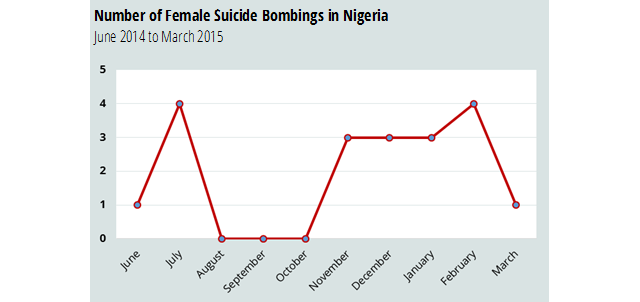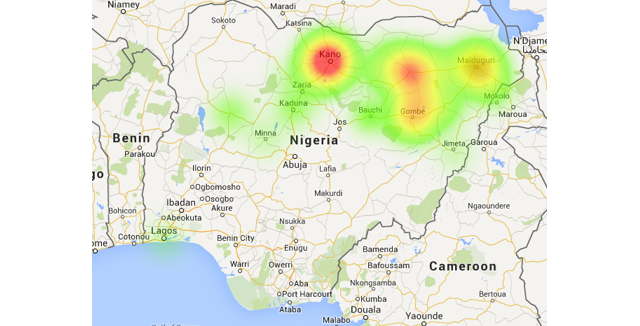BY ANIA SKINNER
Jamāʻat Ahl as-Sunnahlid-daʻwa wal-Jihād (JAS), known widely as Boko Haram, has employed suicide bombers as a terrorist tactic in their insurgency against the Nigerian government since 2011. As of mid-2014, however, reports began to emerge of an alarming new dimension: the use of young women and girls in suicide missions. The first reported case of a female suicide bomber occurred on June 8, 2014, when a woman detonated her bomb near army barracks in Gombe state of Nigeria.
Since that time, the rate of suicide bombings carried out by women has steadily increased. In July 2014, there were four instances of female suicide bombings within one week of each other in Kano state, an area which has been heavily affected by the Boko Haram insurgency. Female suicide bombings spiked again in November with three instances, and each month since then has experienced steady numbers of women detonating themselves in places crowded with civilians.

Graphic 1: Number of female suicide bombings in Nigeria from June 2014-March 2015 using data sources from peace map http://p4p-nigerdelta.org/peace-building-map
Perhaps the most disturbing development is the use of young teenage girls and children to carry out these deadly missions. In January 2015, it was reported that a 10-year old girl blew herself up in a busy market in Maidguri, killing 20 people including herself. In February, a girl believed to be as young as seven detonated her bomb at a Sunday market in Potiskum, killing herself and seven others, and injuring 42.
The majority of these incidents have occurred in the northeastern corner of Nigeria, where Boko Haram has become increasingly active. The insurgency has also gained ground further west in states like Kano, as evidenced by the high number of female suicide bombings carried out in that region. The heat map below shows the concentration of suicide bombings in the past ten months.

Graphic 2: Heat map of suicide bombings reported from June 2014 to March 2015 using all data sources from peace map http://p4p-nigerdelta.org/peace-building-map
It is not completely clear what the motivation is behind Boko Haram’s use of female suicide bombers. Mia Bloom, Professor of Security studies at the University of Massachusetts – Lowell, suggests in the Washington Post that using women to carry out these missions could be a strategy to increase their success, as women are less likely to be suspected of carrying a bomb, less likely to be searched, and are able to better conceal their equipment. This makes female suicide bombers especially dangerous in crowded markets, transportation hubs, and religious sites, all of which are common targets.
Other theories include that many of the women who carry out these missions have been forced into doing so, pointing to evidence that men often accompany the female suicide bombers prior to their detonation, especially the younger women. There has been speculation that some women could be victims of the Chibok school girl kidnapping that occurred last April. However, currently there is no evidence to substantiate these claims.
Although it is highly possible that some women are forced to become female suicide bombers by Boko Haram or are made to feel that they have no other option, it is also possible that others do so on their own initiative. BBC reported that the Nigerian military acknowledged that there seems to be a female component of Boko Haram aimed at recruiting women as spies or wives of insurgents. Other women related or married to Boko Haram insurgents could be motivated by grief over a lost relative or husband, and agree to suicide missions as revenge, as is often seen Chechnya.
However, the increasing regularity of female suicide bombings has also created an atmosphere of suspicion among the Nigerian public. A Nigerian newspaper, The Nation, reported in December that two women wearing hijabs and carrying big bags were nearly lynched by members of the public who suspected them to be suicide bombers despite their innocence. This incident occurred at the Federal University of Technology at Minna in Niger state, an area which has experienced one female suicide bombing in the past ten months.
Most recently, The Vanguard reported that a woman wearing a long hijab who refused to be screened upon entering a market was burned to death by an angry mob on March 1 in Bauchi state. It was later learned that the victim was wrongly identified as a suicide bomber.
Female suicide bombings have developed into a worrying trend and a destabilizing factor in northeastern Nigeria. In order to counter this growing threat, and to prevent more young women and girls from being recruited or forced into committing such brutality, further research is needed to establish the motivations and recruitment methods. Only through a thorough understanding of the root causes driving this new phenomenon, can an effective strategy be deployed for prevention and mitigation that does not result in the loss of more innocent lives.
